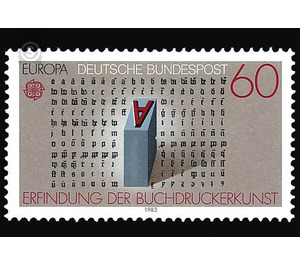Europe: Great works of the human mind - Germany / Federal Republic of Germany 1983 - 60 Pfennig
Theme: Post & Philately
| Country | Germany / Federal Republic of Germany |
| Issue Date | 1983 |
| Face Value | 60.00 |
| Color | brown grey |
| Perforation | K 14:14 1/4 |
| Printing Type | Six-color offset printing |
| Stamp Type | Postage stamp |
| Item Type | Stamp |
| Chronological Issue Number | 1048 |
| Chronological Chapter | GER-BRD |
| SID | 206741 |
| In 61 Wishlists | |
For the Xth Ordinary General Assembly of the CEPT in Brussels, the theme "Great Works of the Human Spirit" has been selected for 1983. Johannes Gensfleisch from the Hof zum Gutenberg, world-famous under the name of Johannes Gutenberg, is always referred to in dictionaries, textbooks and other publications as the inventor of the art of printing. But his real invention was not printing - one printed long before Gutenberg of wood panels or printed with single stamps letters and characters - but the deciding factor of his invention is the hand casting instrument, with which he uses an alloy of lead, antimony, bismuth and tin From the negative molds of the dies made with steel dies, these single letters could be poured and multiplied in large quantities. Thus, the brief was invented, from which one imprinted and duplicated the texts on a printing press copied from the wine press. The patrician's son, born around 1397 in Mainz, most likely developed his pioneering invention 1434-44 in Strasbourg, where he had to temporarily emigrate. In Mainz he then set up his printing office and printed there from 1452 to 1454 as the first printed with movable type large book, the two-volume 42-line Latin Bible, which is considered to be the unrivaled most beautiful book in the world today. Of the presumably 180 to 200 printed copies, each with 1,280 pages, today only 48 have been preserved. Gutenberg achieved the perfect beauty of the sentence picture by cutting and casting a total of 290 letters of different widths instead of the necessary 28 characters for the alphabet, so that the composers had variable options for setting the sentences. The necessary for the Bible printing loans could not repay the big Mainzer at the agreed time. Therefore he lost the process and had to pledge his workshop in 1455. He died in 1468, so he still experienced the great breakthrough of his invention and the success of his successor workshop Fust and Schöffer in Mainz. The Gutenberg Museum of the City of Mainz, which was founded in 1900 in his memory, has since become the much-visited »World Museum of Printing Art«. (Text: Gutenberg Museum, Mainz - Prof. Hans A. Halbey, Director)


